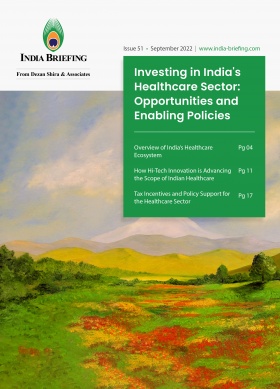Telecom Equipment Makers Meeting with the Government on December 3
Leading global and Indian telecom gear makers are expected to meet with telecom ministry officials on December 3. Top on the agenda will be handholding for the sector and clearing out bottlenecks as the government is ambitious for 5G roll-out across India and building a local manufacturing ecosystem to keep out Chinese stakeholders.
India’s telecom minister Ashwini Vaishnaw is reportedly meeting with global telecom gear makers Nokia, Samsung, Ericsson-owned Jabil, Tata-owned Tejas Networks, Dixon Technologies, Shyam Teleco, HFCI, and ITI on December 3 to gauge how the government can support the sector.
Sources speaking to financial paper Businessline said: “The government is expected to discuss the production linked incentive (PLI) scheme that was given, and also some custom duty reliefs to domestic manufacturers.”
This intention to provide a degree of handholding to telecom gear makers comes as India is keen to develop its local manufacturing ecosystem, boost its 4G and 5G telecom network infrastructure, and keep out Chinese firms due to national security concerns. Both Huawei and ZTE have not been welcomed to invest in India’s 5G roll-out.
PLI schemes for telecom and networking products, design-led manufacturing
Currently, 42 companies, including 28 micro, small, and medium enterprises (MSME), have been selected as beneficiaries of the sector’s production-linked incentives (PLI) scheme by the Department of Telecommunications (DoT).
While detailed breakdown of their respective investment plans are yet to be made public, it was reported early November that domestic gear maker HFCL will invest INR 4.25 billion (US$52.03 million) for equipment manufacturing under the telecom PLI scheme in the next four years. In turn, HFCL will be eligible for incentives worth INR 6.52 billion (US$79.92 million) to be disbursed from FY 2022-23 to FY 2026-27.
Altogether the selected companies have committed to invest INR 41.15 billion (US$503.82 million) under the PLI scheme. Of these, 17 companies, including Nokia, Jabil, and Tejas, have applied for an additional 1 percent incentive under the PLI criteria introduced for 5G design-led manufacturing.
India is keen to upgrade its telecom services to 5G standard and selected telecom equipment makers have reportedly increased their investment under the PLI scheme by more than INR 5 billion (US$61.21 million).
In February 2021, the DoT announced the PLI scheme for telecom and networking products, with a budget outlay of INR 121.95 billion (US$1.49 billion) to be disbursed for a period of five years. The PLI scheme was amended in April this year to introduce 5G design-led manufacturing criteria with an additional incentive of 1 percent over the existing rates of incentive.
Out of the budgeted INR 121.95 billion, INR 40 billion (US$489.74 million) is set aside for this additional PLI incentive. Newly selected applicants and existing beneficiaries who applied for the additional incentive under the design-led manufacturing criteria have altogether committed to investments worth INR 7.7 billion (US$94.27 million).
Overall, the government estimates the telecom PLI scheme to generate additional sales worth INR 2.45 trillion (US$29.99 billion) and create more than 44,000 jobs.
PLI scheme period extended by a year
Several selected companies could not meet their PLI targets last year due to COVID-19 related shocks to the supply chain, which is why the scheme has been extended by a year.
Also, under the amended scheme, existing PLI beneficiaries were allowed to add more products and re-apply for incentives besides shifting their 5-year PLI scheme period by a year.
It should be noted that the companies had to forego their incentives for the financial year ending March 2022 (i.e., FY 2021-22) as a precondition for shifting their PLI scheme period.
Meanwhile, other global firms are keeping an eye on how the PLI scheme benefits the sector. US-based Garmin, makers of premium smartwatches and wearables, has said it is monitoring the scheme’s performance, which could impact its manufacturing plans in India.
India’s demand for 5G equipment
Bharti Airtel and Reliance Jio are steadily rolling out their 5G network offering, creating sudden demand for 5G telecom gear. Consequently, European majors Nokia and Ericsson have upped their production of 5G equipment for the Indian market. Telecom firms aim to add around 10,000 5G sites per week in the next three to four months.
Airtel has rolled out 5G Plus services in 13 locations – Delhi, Mumbai, Chennai, Hyderabad, Bengaluru, Guwahati, Pune (airport), Patna, Panipat, Nagpur, Gurgaon (Gurugram), Siliguri, and Varanasi.
Reliance Jio provides 5G across 46 cities and towns, including Delhi NCR, Mumbai, Varanasi, Kolkata, Chennai, Gujarat, Bengaluru, Hyderabad, and Pune.
In addition to Airtel and Jio, Vodafone Idea will also begin laying down its 5G network over the next couple of months; it is currently in testing mode with 5G services made available at select locations.
Keeping China out of its legacy network
Besides the new 5G roll-out, the state-run Bharat Sanchar Nigam Ltd. (BSNL) will be rolling out its 4G network in the country. Only Indian companies were allowed to bid for this, out of which the contract was awarded to a Tata Consultancy Services (TCS)-led consortium. The deal is worth close to INR 270 billion (US$3.30 billion).
Impact of 5G on India’s GDP
Industry body Nasscom projects that by 2030, 5G services will boost India’s GDP by 2 percent, amounting to US$180 billion. It likely factors the current pace of internet penetration in India, anchored by booming sales of smartphones and the expansion of the digital economy. As industries rapidly digitize, they require low latency networks (optimized to process high data volumes with minimal delays) and machine to machine communication. This bodes well for 5G adoption in India, which is also home to leading global IT hubs.
Nasscom notes that India has 10 million active 5G smartphones and 30 million new shipments were received last year. This is expected to accelerate as the 5G roll-out picks pace. At the first 5G auction round, 71 percent of the total GHz capacity was secured for INR 1.5 trillion (about US$20 billion). Meanwhile, policies like the National Optical Fiber Network (NOFN) plan to connect all 250,000 gram panchayats (village governing bodies) in the country will facilitate rapid grassroot 5G adoption. According to Airtel, the tariff plans for 5G are expected to be similar to 4G in India.
In terms of growth of subscribers in India in the last 5-6 years, telecom subscriptions recorded 3.37 percent compound annual growth (CAGR) between 2015 and 2019 while internet subscribers grew at 20.5 percent CAGR during the same period.
Digital data consumption in India grew at 113 percent CAGR between 2014 and 2019, shooting up from 828 million GB to 76,320 million GB, respectively. Forty million new users joined India’s 4G network in 2021, bringing the total to about 740 million.
This article was originally published November 25, 2022. It was last updated November 29, 2022.
About Us
India Briefing is produced by Dezan Shira & Associates. The firm assists foreign investors throughout Asia from offices across the world, including in Delhi and Mumbai. Readers may write to india@dezshira.com for more support on doing business in in India.
We also maintain offices or have alliance partners assisting foreign investors in Indonesia, Singapore, Vietnam, Philippines, Malaysia, Thailand, Italy, Germany, and the United States, in addition to practices in Bangladesh and Russia.
- Previous Article Profiling Major Segments in India’s Education Industry
- Next Article India’s Shipping and Port Infrastructure Upgrades to Get Fast-Tracked









